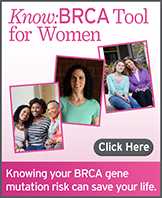Know:BRCA Tool

Some women carry certain genetic changes in their BRCA genes that increase their risks for getting breast, ovarian, and other kinds of cancers at a young age. BRCA stands for BReast CAncer susceptibility gene. There are two BRCA genes: BRCA1 and BRCA2. Normally, they help protect you from getting cancer. But when you have changes or mutations on one or both of your BRCA genes, cells are more likely to divide and change rapidly, which can lead to cancer.
Without treatment, women with a BRCA gene mutation are seven times more likely to get breast cancer and 30 times more likely to get ovarian cancer before age 70 than other women.
What Is the Know:BRCA tool?
The Know:BRCA online tool is a resource developed to help women understand their risks for having a BRCA1 or BRCA2 gene mutation.
How the Know:BRCA Tool Works
The Know:BRCA tool estimates your chance of having a BRCA gene mutation based on your personal and family history of cancer. It looks at how many people in your family have had breast or ovarian cancer, how they are related to you, and how old they were when they got cancer. The more information you enter about your family’s history of cancer, the more accurate the estimate will be.
What the Know:BRCA Tool Does
Based on the information you provide about your personal and family cancer history, the Know:BRCA tool tells you which of two groups you are in—
- You have an above-average chance of having a BRCA gene mutation.
- You do not have an above-average chance of having a BRCA gene mutation.
The tool cannot tell you—
- If you actually have a BRCA gene mutation.
- If you have cancer.
- If you have other risk factors for getting cancer.
Share Your Family Cancer History with Your Doctor
The Know:BRCA tool is not perfect. It is very important to share your results with your doctor, who can confirm whether you are more likely to have a BRCA gene mutation. Learning your risk can help you and your doctor make important decisions about your health.
- Page last reviewed: October 29, 2014
- Page last updated: October 29, 2014
- Content source:



 ShareCompartir
ShareCompartir